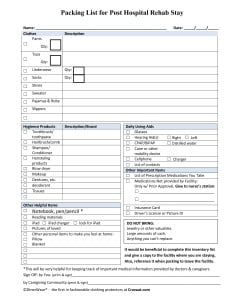As a follow up to last week, we’re providing a Packing Checklist – Post Hospital Rehab Stay to help save you time, and help make move-in/move-out go more smoothly for you or a loved one.
Unlike a hospital, a transitional rehabilitation center will expect you to have your own personal items during care because you will be up and around and in public areas. While they do provide medications, and other care products (such as towels, bedding, and medical care related items like incontinence products, and wound care products), you will your own daily living items such as clothes, pajamas, hygiene products, and other personal products as per our list last week. Remember that the more comfortable and at home you can feel, the quicker your recovery.
How to use this Packing Checklist – Post Hospital Rehab Stay:
- Use the checklist to determine what to pack. Review the list with the care-receiver and let them determine what they want. They can also tell you where to find the items in their home.
- Record what items were packed and brought to the care facility.
- Provide the checklist to the care facility at the beginning of your stay so they have a record of what you came with in case anything goes missing. Some care facilities have their own inventory checklist. Either way, documenting your belongings will help both you and the facility if/when questions arise. Be sure to get sign-off, and to keep a copy for yourself.
- Use the list throughout the stay if taking items home and bringing new items. Update the list as it changes.
- Use the checklist as as a cross-reference when packing to go home to make sure you leave with everything you came with.
Here is a downloadable checklist for you to print: Packing Checklist – Post Hospital Rehab Stay

Keep these packing tips in mind:
Clothes should be easy on/easy off. Elastic waist pants are the easiest. But consider one bottom and one top that will be typical for the care-receiver to wear at home so that they will have a chance to practice dressing him/herself before returning home.
Shoes should be non-slip. Athletic shoes that are slip on or velcro are best. Nothing open backed.
Allow for layering. Light shirts with sweaters or jackets let you add or remove when the care-receiver gets warm or cold.
Hygiene items will help the resident feel fresh and well groomed everyday and more like their normal self.
Though the care-receiver will be busy and worn out from therapy and other recovery activities, you may want items to help them stay busy or help them feel comfortable, such as: books to read, crossword puzzles, adult coloring books, cards, or an iPad.
When bringing more expensive (but still replaceable) items, have a way to lock them up and secure them in the room. No one wants to lose the item, and it’s difficult to say how these things disappear, but they do. Be aware and be prepared.
Leave valuables at home. This includes expensive make-up and creams, jewelry, including wedding rings. You will need little to no cash.
*A Notebook and pen/pencil is a great item to have on hand for when caregivers (doctors, therapists, etc.) visit and provide updates on your care. This gives the care-receiver or loved one the ability to write the information down to keep track of progress, to share with other family members, and to simply remember what was said. This will be one of your best care companions.
The Packing Checklist – Post Hospital Stay is especially helpful when various family members are participating in care. Keep this list in a central location, so if changes need to be made or if it needs to be referenced, anyone can find it. If one family member packed, but another family member is bringing the loved one home, this is a great and simple way to let each other know exactly what to expect.
And remember, though it’s not on the checklist, a Cravaat dining scarf or Napkin at Your Neck is a great alternative to an adult bib to keep your clothes clean while eating in a rehab facility. Stay stylish while dining with dignity.


It’s wondurfel to have you on our side, haha!